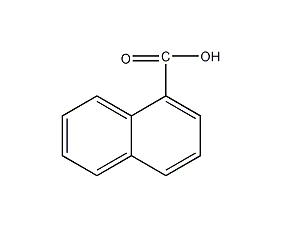
Structural formula
| Business number | 01WU |
|---|---|
| Molecular formula | C11H8O2 |
| Molecular weight | 172.18 |
| label |
a-naphthoic acid, 1-Naphthoic acid, a-Naphthoic Acid, C10H7CO2H |
Numbering system
CAS number:86-55-5
MDL number:MFCD00004007
EINECS number:201-681-9
RTECS number:QL0960000
BRN number:1908896
PubChem number:24886077
Physical property data
1. Properties: White needle-like crystals.
2. Density (g/mL, 25/4℃): 1.398
3. Relative vapor density (g/mL, air=1): Undetermined
4. Melting point (ºC): 162℃
5. Boiling point (ºC): 23150℃
6. Gas phase standard heat of combustion ( Enthalpy) (kJ·mol-1): -5248.8
7. The gas phase standard claims heat (enthalpy) (kJ·mol-1): -223.1
8. Crystalline phase standard combustion heat (enthalpy) (kJ·mol-1): -5138.4
9. Crystalline phase standard claim Heat (enthalpy) (kJ·mol-1): -333.5
10. Autoignition point or ignition temperature (ºC): Undetermined
11 . Vapor pressure (kPa, 25ºC): Undetermined
12. Saturated vapor pressure (kPa, 60ºC): Undetermined
13. Heat of combustion (KJ/mol): Undetermined
14. Critical temperature (ºC): Undetermined
15. Critical pressure (KPa): Undetermined
16. Oil and water (octanol/water) Log value of distribution coefficient: Undetermined
17. Explosion upper limit (%, V/V): Undetermined
18. Explosion lower limit (%, V/V): Undetermined
19. Solubility: Easily soluble in hot alcohol and ether, slightly soluble in hot water
Toxicological data
1. Acute toxicity:
Mouse caliber LD50: 2370mg/kg;
Acute toxicity:
Main irritant effects:
On skin: Irritation to skin and mucous membranes.
On the eyes: effects of irritation.
Sensitization: No known sensitizing effects.
Ecological data
General remarks
Water hazard class 1 (German Regulation) (self-assessment via list) The substance is slightly hazardous to water.
Do not allow undiluted or large amounts of product to come into contact with groundwater, waterways or sewage systems.
Do not discharge materials into the surrounding environment without government permission.
Molecular structure data
1. Molar refractive index: 51.02
2. Molar volume (cm3/mol): 136.0
3. Isotonic specific volume (90.2K): 373.2
4. Surface tension (dyne/cm): 56.5
5. Polarizability (10-24cm3): 20.22
Compute chemical data
1. Reference value for hydrophobic parameter calculation (XlogP): 3.1
2. Number of hydrogen bond donors: 1
3. Number of hydrogen bond acceptors: 2
4. Number of rotatable chemical bonds: 1
5. Topological molecular polar surface area (TPSA): 37.3
6. Number of heavy atoms: 13
7. Surface charge: 0
8. Complexity: 200
9. Number of isotope atoms: 0
10. Determine the number of atomic stereocenters : 0
11. Uncertain number of atomic stereocenters: 0
12. Determined number of chemical bond stereocenters: 0
13. Uncertain chemical bond positions Number of structural centers: 0
14. Number of covalent bond units: 1
Properties and stability
None yet
Storage method
Seal and store in a dry and dark place at 4°C
Synthesis method
First, prepare 1-naphthyl magnesium bromide by combining 1-bromonaphthalene with magnesium chips and absolute ether in the presence of a little iodine. After dissolving it in benzene, add carbon dioxide and control the reaction at -7–2℃. . Then 25% sulfuric acid is slowly added until the reaction no longer proceeds and excess magnesium is dissolved. Separate the benzene layer, extract the 1-naphthoic acid in it with 25% sodium hydroxide solution, acidify with 50% sulfuric acid to precipitate the crude product, and recrystallize with toluene to obtain the finished product with a yield of about 70%.
Purpose
Used as raw material for photographic film base; in photosensitive resin, used in printed circuit boards, plate-making films, photoresists, photosensitizers; modified additives for special resins.

 微信扫一扫打赏
微信扫一扫打赏

